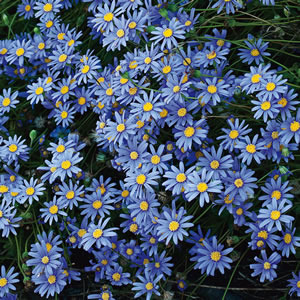Blue Marguerite Growing Guide

What is Blue Marguerite?
Blue Marguerite (Felicia amelloides) also known as Blue Daisy, Agathea or Blue Kingfisher Daisy is bushy spreading evergreen perennial. It is part of the Asteraceae family and is native to South Africa. Blue Marguerite is a fast growing plant that has bright blue daisy-like flowers which cover the pretty foliage for much of the year. The foliage is roundish green shaped leaves that grows well in a full sun position however does like the protection from the hot afternoon sun. Blue Marguerite bloom from Spring to Autumn in climates where Summers are not super hot. If the Summer heat is really hot the blooms retreat until it is cooler.
Benefits of Growing Blue Marguerite
Blue Marguerite is a very quick to establish and low maintenance plant. It is hardy, fast growing, long flowering, long lived and wind and drought resistant. A naturally rounded growth habit makes this ground cover ideal for pots, borders, rockeries and mixed garden beds. It is well suited to a cottage garden setting. Blue Marguerite attracts bees and butterflies.
How to Grow Blue Marguerite
Climatic Zones
Cool to tropical
Plant Size
Height: 30cm, Width: 50cm
When To Plant Blue Marguerite
Plant in Spring after the last frost if grown from seed. Anytime for a potted plant.
Soil Preparation
Well drained soils enriched with plenty of organic matter. Dig through well broken down animal manure or compost before planting.
How To Plant Blue Marguerite
Plant in full sun to part shade, 1-1.2m apart with the plant crown at soil level.
Blue Marguerite Plant Care
Keep well watered in Summer. Mulching will also help by retaining the moisture.
Fertilise with a slow release fertiliser at the start of Spring when new growth starts forming.
Prune in late Autumn. Trim plant lightly after main flowering to maintain a compact shape, and to remove spent flowers. Deadheading will promote more blooms to appear.







